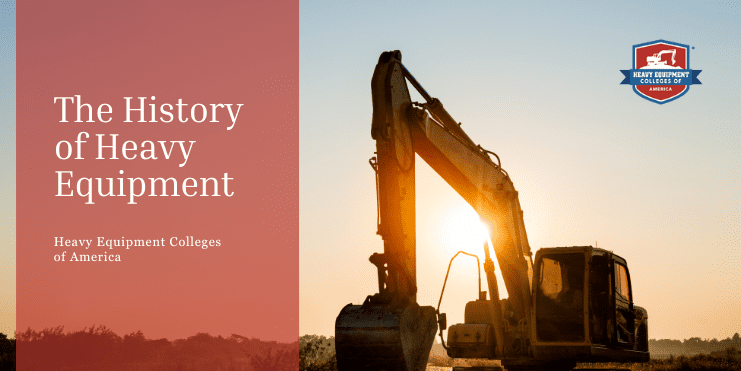The next time you drive through the city or town in which you reside, take a minute to look at the buildings and roads around you. Did you ever stop to think about the process and the work that was required to bring these valuable staples of civilization infrastructure into being? Just in case you didn’t know, a specific class of construction machinery, known as heavy equipment, was most certainly integral to the construction of roads, buildings and more. Backhoes, bulldozers, cranes and the people who operate them help take the country’s continuing development from conception to reality.
The History of Heavy Equipment: Heavy Equipment Timeline
Late 1800s
The second Industrial Revolution in the United States is the primary reason for the use of machines across the country, most notably in agriculture. In 1886, Benjamin Holt created his first combine harvester, followed by a steam engine tractor four years later in 1890. Not to be outdone, John Froelich invented the gas-powered tractor soon after that in 1892. These inventions would help pave the way for heavy equipment.

1900s
In 1906, Holt ran his gas-powered track-type tractor, which was the first of its kind. His “caterpillar” tractor utilized continuous track technology first seen on a commercial vehicle in 1901 on a machine called the Lombard Steam Log Hauler. The continuous tractor would revolutionize not only agricultural equipment, but military vehicles as well. The metal track technology would be applied to tanks and other vehicles in World War I and beyond.
1920s
The 1920s marked the advent of bucket wheel excavators. The high-powered mining tools, which are the largest heavy machines, were invaluable in mining precious minerals. During the 1920s, heavy machine companies became more commonplace and established ones started to merge and grow (e.g., Holt, which later became Caterpillar).
The 1920s also saw the invention of various other machines that are frequently used in construction today, such as the bulldozer, which utilized continuous metal track technology.
1930s
Like other industries, the heavy machinery industry was affected by the Great Depression of the 1930s. Many manufacturers had to resort to selling parts and equipment abroad to help stay afloat during the tough economic times. That’s not to say that there wasn’t big infrastructure during the 1930s, because landmarks such as the Golden Gate Bridge were still erected during the decade with the use of heavy machines.
1950s–1970s
The aftermath of World War II prompted not only a boom in babies but suburban residential and commercial expansion as well. Swaths of individuals, especially those who were married, were leaving densely populated urban areas to raise families in newly constructed suburban subdivisions. Heavy machines, as you might have been able to guess, played a crucial role in this movement as well.
The 1950s were also a great time for the heavy machinery and construction industries because of the Federal-Aid Highway Act of 1956, signed into law by President Dwight D. Eisenhower. The law resulted in the construction of the interstate highway system as we know it today. These highways were constructed in part to ease the transport of military equipment and other assets across the country. They were also designed with the thought that cities could be easily evacuated in the event of various catastrophes. Though the bill became law in 1956, the project took 35 years and countless hours of labor to complete.

1980s
The 1980s were not as kind to the industry as the previous three decades had been. The work on the interstate highway system was for the most part finished and the demand for the machines was not as strong. As a result, many heavy equipment companies folded or merged to form a few large companies. It was during this time that Caterpillar emerged as the biggest company for heavy equipment in America.
1990s
The 1990s saw an increase in demand for more compact heavy equipment. New environmental regulations forced heavy machine companies to change the engines in their equipment to curtail carbon emissions.
2000s
Heavy equipment manufacturers had to begin to accommodate the demand for machine rentals as opposed to purchasing heavy equipment. Rental companies purchased heavy equipment machines, but they had different specifications for the ones they purchased compared to fancier models that a private contractor would be looking to buy. Manufacturing companies also continued innovations in fuel efficiency and carbon emissions to reduce fuel costs and environmental impact.
The Future
As technology becomes increasingly advanced and other kinds of engines become commonplace, the heavy equipment industry may likely implement such innovations just as it has in the past.
In addition, as residential and commercial development continues across the United States, the demand for heavy equipment and those who operate the machines is expected to remain steady.
According to projections from the Bureau of Labor Statistics, the employment of construction equipment operators will increase by 10 percent, a faster-than-average rate, through 2024.
If you are thinking about how this brief history of heavy equipment has inspired you to pursue a career in construction, all you need now is an educational training program that can set you up with the skills needed to work a job in construction or handling heavy equipment.
Build Your Dreams with an HEC Education
The Heavy Equipment Colleges of America (HEC) is a group of some of the premier heavy equipment schools in the nation. At one of HEC’s locations, you can attain the knowledge you need to succeed as a heavy equipment operator. HEC offers its course at four campuses across the country.




